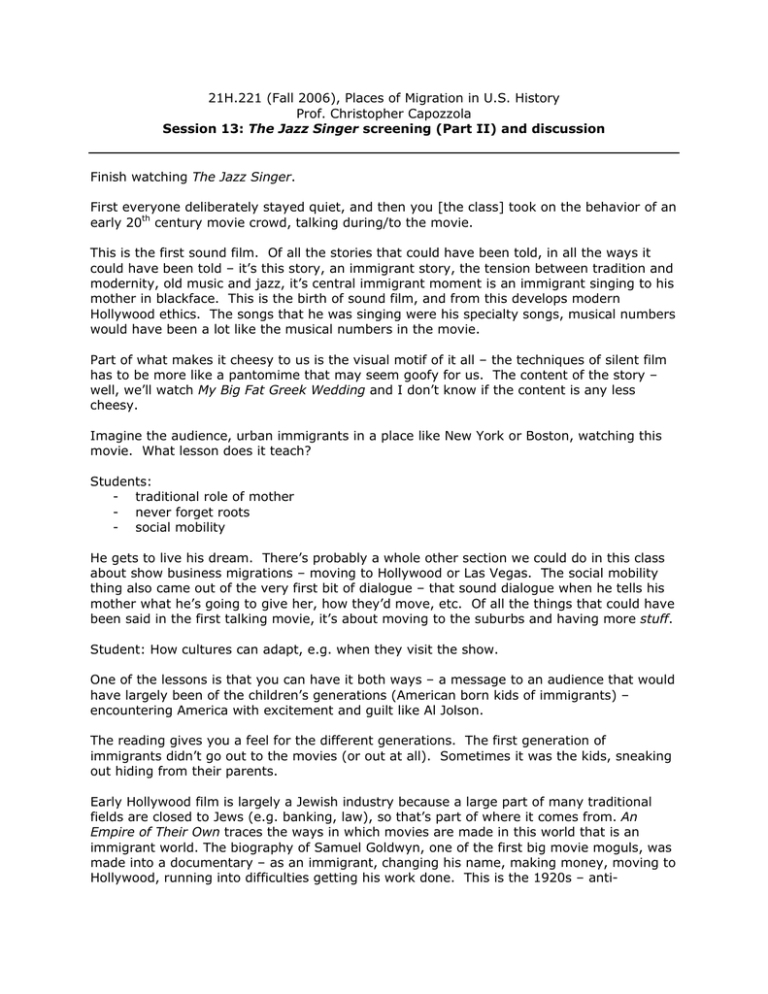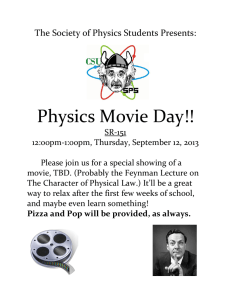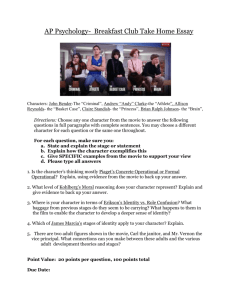21H.221 (Fall 2006), Places of Migration in U.S. History
advertisement

21H.221 (Fall 2006), Places of Migration in U.S. History Prof. Christopher Capozzola Session 13: The Jazz Singer screening (Part II) and discussion Finish watching The Jazz Singer. First everyone deliberately stayed quiet, and then you [the class] took on the behavior of an early 20th century movie crowd, talking during/to the movie. This is the first sound film. Of all the stories that could have been told, in all the ways it could have been told – it’s this story, an immigrant story, the tension between tradition and modernity, old music and jazz, it’s central immigrant moment is an immigrant singing to his mother in blackface. This is the birth of sound film, and from this develops modern Hollywood ethics. The songs that he was singing were his specialty songs, musical numbers would have been a lot like the musical numbers in the movie. Part of what makes it cheesy to us is the visual motif of it all – the techniques of silent film has to be more like a pantomime that may seem goofy for us. The content of the story – well, we’ll watch My Big Fat Greek Wedding and I don’t know if the content is any less cheesy. Imagine the audience, urban immigrants in a place like New York or Boston, watching this movie. What lesson does it teach? Students: - traditional role of mother - never forget roots - social mobility He gets to live his dream. There’s probably a whole other section we could do in this class about show business migrations – moving to Hollywood or Las Vegas. The social mobility thing also came out of the very first bit of dialogue – that sound dialogue when he tells his mother what he’s going to give her, how they’d move, etc. Of all the things that could have been said in the first talking movie, it’s about moving to the suburbs and having more stuff. Student: How cultures can adapt, e.g. when they visit the show. One of the lessons is that you can have it both ways – a message to an audience that would have largely been of the children’s generations (American born kids of immigrants) – encountering America with excitement and guilt like Al Jolson. The reading gives you a feel for the different generations. The first generation of immigrants didn’t go out to the movies (or out at all). Sometimes it was the kids, sneaking out hiding from their parents. Early Hollywood film is largely a Jewish industry because a large part of many traditional fields are closed to Jews (e.g. banking, law), so that’s part of where it comes from. An Empire of Their Own traces the ways in which movies are made in this world that is an immigrant world. The biography of Samuel Goldwyn, one of the first big movie moguls, was made into a documentary – as an immigrant, changing his name, making money, moving to Hollywood, running into difficulties getting his work done. This is the 1920s – anti- immigration nativism. Anti-semitism flares up – and the fact that Hollywood is a Jewish industry is how Hollywood and Jews get linked in America. Love and Theft is about the complicated cultural relationships between American Jews and American blacks, particularly in media and entertainment. What are immigrants becoming? American, modern, capitalist workers. The story of movie going is the story of how mass culture makes them into modern urban consumers, and this movie is about that. Think about that in conjunction with factory work in Lawrence. The presence of the blackface singer brings up the question of whether European immigrants are becoming white, adopting American understandings of racial identity. Europeans didn’t have much experience with black people before migrating to the US and then within such a short period of time can be out there performing in these racist, stereotypical ways – what does that mean about how these immigrants think about who they are and what their identity is, not just about relationships between blacks and Jews in the 1920s. 21H.221 (Fall 2006), Places of Migration in U.S. History Christopher Capozzola Session 13 Page 2 of 2



